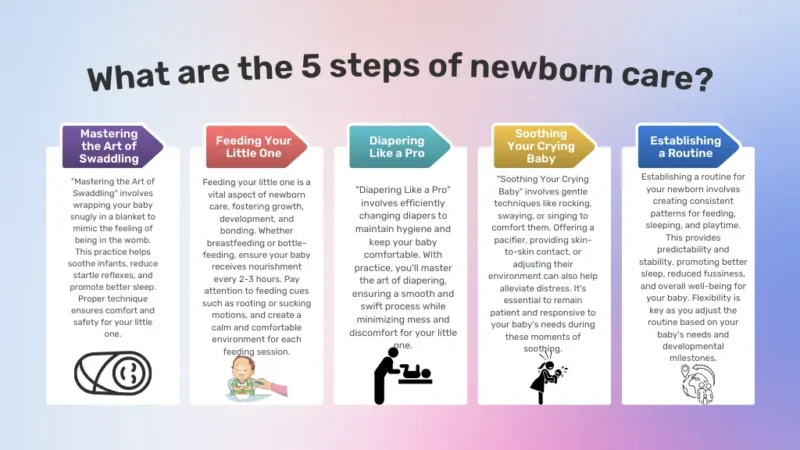Welcoming a newborn into your life is an exhilarating journey filled with wonder and responsibility.
Amidst the joy, it’s essential to prioritize their care with diligence and expertise. Understanding the five fundamental steps of newborn care lays a sturdy foundation for nurturing your bundle of joy.
From Mastering the Art of Swaddling to Establishing a Routine, each step plays a crucial role in ensuring your baby’s well-being and comfort.

Join us as we delve into these essential steps, guiding you through the intricacies of caring for your newest family member with confidence and care.
What are the 5 steps of newborn care?
The five steps of newborn care encompass essential aspects crucial for the well-being of your little one. Mastering the Art of Swaddling ensures your baby feels snug and secure, replicating the comforting environment of the womb.
Feeding Your Little One is vital for their growth and development, whether through breastfeeding or bottle-feeding, providing nourishment, and fostering bonding moments.
Diapering Like a Pro involves efficiently changing diapers to maintain hygiene and keep your baby comfortable.
Soothing Your Crying Baby requires patience and understanding as you employ various techniques to calm them, such as gentle rocking or singing.
Finally, Establishing Routine aids in creating predictability for both you and your baby, promoting better sleep and overall well-being.
By following these steps, you can ensure comprehensive care for your newborn, nurturing them in their earliest days of life.
Step 1: Mastering the Art of Swaddling
Picture this: you’ve just brought your little bundle of joy home, and they’re fussing up a storm. What’s a parent to do? Enter the ancient technique of swaddling.
Swaddling your newborn is like wrapping them in a cozy, womb-like cocoon, providing a sense of security and comfort that can calm even the fussiest of babes.

Questions about Swaddling:
- How do I swaddle my baby correctly?
- What are the benefits of swaddling?
- When should I stop swaddling my baby?
Swaddling your newborn is an art form that takes a bit of practice, but once you’ve mastered it, you’ll be a pro at soothing your little one. Imagine being able to quickly and easily calm your baby’s cries with a simple yet effective swaddle technique. It’s like having a secret superpower!
- How do I swaddle my baby correctly?: To swaddle your baby correctly, lay a blanket flat, fold one corner down, and place your baby on its back with its head above the folded corner. Wrap one side of the blanket over their body and tuck it under their back, then fold the bottom corner up and wrap the other side snugly around them, tucking it securely.
- What are the benefits of swaddling?: Swaddling can help soothe babies by replicating the cozy feeling of being in the womb, promoting better sleep patterns, and reducing the startle reflex. It can also provide a sense of security and comfort, aiding in the overall well-being of the baby.
- When should I stop swaddling my baby?: You should stop swaddling your baby when they start showing signs of rolling over independently, usually around 2 to 4 months of age. Once your baby can roll over, swaddling can pose a suffocation risk, so it’s essential to transition them to alternative sleep practices, such as using a sleep sack or letting them sleep unswaddled.
The Swaddling Technique
To swaddle your baby, you’ll need a thin, lightweight blanket. Spread it out in a diamond shape, and place your baby face-up in the center.
Gently take one corner of the blanket and pull it across their body, tucking it under their back. Repeat with the opposite corner, creating a snug wrap around their torso.
Finally, take the remaining corners and tuck them under your baby’s body, ensuring their arms are securely tucked in.
Remember, your baby’s safety is paramount, so always ensure the swaddle isn’t too tight or loose. With a bit of practice, you’ll be a swaddling pro in no time!
Benefits of Swaddling
Swaddling offers numerous benefits for your newborn, including:
- Promoting a sense of security and comfort reminiscent of the womb
- Helping to calm fussiness and prevent startling
- Encouraging better sleep patterns
- Reducing the risk of Sudden Infant Death Syndrome (SIDS)
Just be sure to stop swaddling once your baby starts rolling over or shows signs of trying to break free, typically around 2-3 months of age.
Step 2: Feeding Your Little One
Ah, feeding time – the moment your newborn reminds you just how loudly those tiny lungs can wail.
Whether you choose to breastfeed or bottle-feed, nourishing your baby is a top priority. But fear not, dear parent, for we’ve got some tips to make this journey a little smoother.

Questions about Feeding:
- How often should I feed my newborn?
- What are the signs that my baby is hungry?
- How do I properly hold my baby during feedings?
Feeding your newborn is more than just providing sustenance – it’s a precious bonding experience.
Imagine cradling your little one in your arms, gazing into their eyes as they contentedly suckle away. It’s a moment that encapsulates the beauty of parenthood and one you’ll cherish forever.
- How often should I feed my newborn?: Newborns typically need to be fed every 2-3 hours or whenever they show signs of hunger. This frequent feeding schedule helps ensure they receive enough nourishment for their rapid growth and development.
- What are the signs that my baby is hungry?: Signs that your baby is hungry include rooting (turning their head toward your hand or breast), sucking on their hands or fingers, making sucking motions with their mouth, fussiness, or crying. It’s essential to respond promptly to these cues to prevent your baby from becoming overly hungry or agitated.
- How do I properly hold my baby during feedings?: There are several positions you can use to keep your baby during feedings, including the cradle hold, football hold, or cross-cradle hold. Whichever position you choose, ensure your baby’s head and body are supported and they are facing your breast or bottle nipple. Hold them close to your body, with their nose in line with your nipple, to promote a comfortable and efficient feeding experience.
Breastfeeding or Bottle-feeding
Whether you choose to breastfeed or bottle-feed, the key is to be patient and responsive to your baby’s cues.
Newborns have tiny tummies, so they’ll need to eat frequently – roughly every 2-3 hours. Look for signs like rooting, sucking motions, or fussiness, which may indicate hunger.
If breastfeeding, remember that it’s a learning experience for both you and your baby. Don’t hesitate to seek guidance from a lactation consultant or your healthcare provider if you encounter any challenges.
For bottle-feeding parents, be sure to sterilize and properly prepare bottles and formulas according to manufacturer instructions. And remember, bonding isn’t just for breastfeeding – cuddle your little one close during bottle feedings, too.
Feeding Positions and Tips
Proper positioning is crucial during feedings to ensure your baby’s comfort and safety. For breastfeeding, try the cradle hold, cross-cradle hold, or football hold. For bottle-feeding, the cradle hold or semi-upright position can work well.
Remember to burp your baby frequently during and after feedings to release any trapped air. And don’t be discouraged if feedings are messy at first – you’ll both get the hang of it with time and patience.
Step 3: Diapering Like a Pro
Ah, diapering – the not-so-glamorous side of parenthood. But fear not, for we’ve got some tips to make this task a little less daunting (and smelly).

Questions about Diapering:
- How often should I change my baby’s diaper?
- What supplies do I need for diapering?
- How do I properly dispose of dirty diapers?
Diapering may seem like a mundane task, but it’s an essential part of your baby’s health and comfort. Imagine being able to swiftly and expertly change your little one’s diaper, preventing any unpleasant accidents or rashes. It’s a skill that will serve you well during those early months (and years!).
- How often should I change my baby’s diaper?: It’s recommended to change your baby’s diaper every 2-3 hours, or as soon as it becomes soiled or wet. Keeping your baby’s diaper clean and dry helps prevent diaper rash and discomfort.
- What supplies do I need for diapering?: Essential supplies for diapering include diapers (cloth or disposable), wipes or washcloths, diaper rash cream or ointment, diaper changing pad or mat, and a diaper pail or trash can with a lid for disposing of dirty diapers.
- How do I properly dispose of dirty diapers?: To properly dispose of dirty diapers, first, ensure you’ve securely closed the diaper to contain any mess. If using disposable diapers, place them in a diaper pail with a lid or in a trash can lined with a plastic bag. For cloth diapers, rinse off any solid waste before placing them in a diaper pail or wet bag until they can be laundered. Always wash your hands thoroughly after handling dirty diapers to maintain hygiene.
Diapering Supplies and Techniques
Before you start, gather your supplies: clean diapers, wipes, diaper cream (if needed), and a changing pad or mat. Having everything within reach will make the process smoother and less stressful.
When changing your baby, be sure to follow these steps:
- Lay your baby down on a clean, flat surface.
- Unfasten the soiled diaper, but leave it under your baby to prevent messes.
- Use wipes to clean your baby’s bottom, front to back gently.
- Apply diaper cream if needed in order to avoid rashes.
- Slide the fresh diaper under your baby, fasten it snugly, and voilà!
Remember, never leave your baby unattended on the changing surface, even for a moment.
Disposing of Dirty Diapers
As for disposing of those dirty diapers, it’s best to use a diaper pail or tightly sealed plastic bag.
This will help contain odors and prevent any unwanted messes. If using cloth diapers, follow the recommended washing and sanitizing instructions.
And don’t worry – with time and practice, you’ll become a diapering pro, able to tackle even the messiest of situations with ease.
Step 4: Soothing Your Crying Baby
Ah, the sound of a crying baby – it’s enough to send even the most seasoned parent into a panic. But fear not, dear parent, for we’ve got some tried-and-true techniques to help soothe your little one’s tears.

Questions about Soothing a Crying Baby:
- What are some practical ways to calm a crying baby?
- How can I identify the cause of my baby’s crying?
- What should I do if nothing seems to be working?
Soothing a crying baby is like solving a puzzle – you’ll need to try different techniques until you find the one that works for your little one. But don’t worry, with a bit of patience and a whole lot of love, you’ll be a pro at calming those cries in no time.
- What are some practical ways to calm a crying baby?: Practical ways to calm a crying baby include gentle rocking or swaying, offering a pacifier, providing skin-to-skin contact, singing or playing soft music, going for a walk in a stroller or baby carrier, or giving your baby a warm bath. Experiment with different techniques to see what works best for your baby.
- How can I identify the cause of my baby’s crying?: To identify the cause of your baby’s crying, check for common reasons such as hunger, tiredness, discomfort (e.g., wet or soiled diaper, too hot or too cold), overstimulation, or illness. Pay attention to your baby’s cues and try to address their needs accordingly.
- What should I do if nothing seems to be working?: If nothing seems to be working to calm your baby, it’s essential to stay calm and patient. Double-check for any signs of discomfort or hunger, try changing their environment (e.g., dimming lights, reducing noise), or seek support from a partner, family member, or friend. If you’re concerned about your baby’s crying or suspect they may be unwell, don’t hesitate to contact your pediatrician for guidance and reassurance.
Identifying the Cause of Crying
Before you can soothe your baby, it’s essential to try and identify the cause of their distress. Are they hungry? Tired?
Wet or soiled? Are you experiencing gas or colic? Once you’ve narrowed it down, you can better address their needs.
If your baby’s crying seems inexplicable, try running through a mental checklist: have they been fed, changed, and burped recently? Are they too hot or too cold? Could they be overstimulated or in need of some quiet time?
Soothing Techniques to Try
Now, let’s explore some tried-and-true soothing techniques:
- Rocking or swaying: The gentle motion can be incredibly calming for babies.
- Shushing or white noise: Mimic the soothing sounds of the womb with a soft “shush” or white noise machine.
- Skin-to-skin contact: The warmth and closeness can work wonders for a fussy baby.
- Baby-wearing: Strapping your little one close in a carrier can provide comfort and security.
- Pacifier: The sucking motion can be calming for some babies.
Remember, every baby is different, so don’t be discouraged if a technique that worked for someone else doesn’t seem to work for your little one. With time and patience, you’ll discover what works best for soothing your baby’s cries.
Step 5: Establishing a Routine
In the midst of all the chaos and sleepless nights, establishing a routine for your newborn may seem like a pipe dream.
But trust us, dear parent, having a consistent schedule can work wonders for both you and your little one.
Questions about Establishing a Routine:
- Why is a routine important for newborns?
- How do I create a routine that works for my baby?
- What should a typical newborn routine include?
Imagine a world where your baby’s needs are met before they even have to cry, where naptimes and feedings flow seamlessly, and you can actually plan your day around a predictable schedule. Sounds like a dream, right? Well, with a solid routine in place, it can become your reality.
- Why is a routine important for newborns?: A routine is crucial for newborns as it provides them with a sense of security, predictability, and stability in their environment. Having a consistent routine can help regulate your baby’s sleep patterns, feeding times, and overall behavior, which can contribute to better sleep quality, reduced fussiness, and improved development.
- How do I create a routine that works for my baby?: To create a routine that works for your baby, start by observing their natural patterns and cues for feeding, sleeping, and waking. Establish consistent times for feeding, napping, and bedtime, and gradually introduce routines such as bath time or storytime to signal transitions. Be flexible and patient as you adjust the routine based on your baby’s needs and development.
- What should a typical newborn routine include?: A typical newborn routine should include feeding sessions every 2-3 hours, napping periods throughout the day, and regular opportunities for bonding and interaction with caregivers. Additionally, incorporate activities such as diaper changes, tummy time, and gentle play to stimulate your baby’s development and provide structure to their day. As your baby grows, you can gradually adjust the routine to accommodate changes in their sleep patterns and feeding habits.
The Benefits of a Routine
Establishing a routine for your newborn offers numerous benefits, including:
- Promoting better sleep patterns
- Reducing fussiness and crying
- Supporting healthy physical and emotional development
- Allowing for more predictability and structure in your day
While it may take some time and adjustments to find the right routine, the payoff is well worth it for both you and your baby.
Creating a Newborn Routine
So, how do you go about establishing a routine? Start by observing your baby’s natural sleep-wake cycles and feeding patterns.
Then, create a schedule that aligns with these patterns, incorporating regular naptimes, feedings, playtime, and quiet moments throughout the day.
Remember, flexibility is vital – your baby’s needs may change as they grow and develop, so be prepared to adjust the routine as necessary. And don’t beat yourself up if things don’t go perfectly – parenting is a learning process, and every day is an opportunity to try again.
Conclusion:
Congratulations, new parent! You’ve just embarked on the most incredible journey of your life, and with these 5 essential steps for newborn care, you’re well on your way to mastering the art of parenthood.
Remember, each step – from swaddling to feeding, diapering to soothing, and establishing a routine – is designed to nurture your baby’s physical and emotional well-being while also making your life a little easier.
Embrace the challenges and cherish the moments, for they will pass all too quickly. Above all, trust your instincts – you’ve got this, and your little one is the luckiest baby in the world to have you as their parent.
So, take a deep breath, hold your baby close, and know that you’re not alone on this incredible journey. With love, patience, and a little humor, you’ll navigate these early days with grace and create a lifetime of cherished memories with your precious little one.

